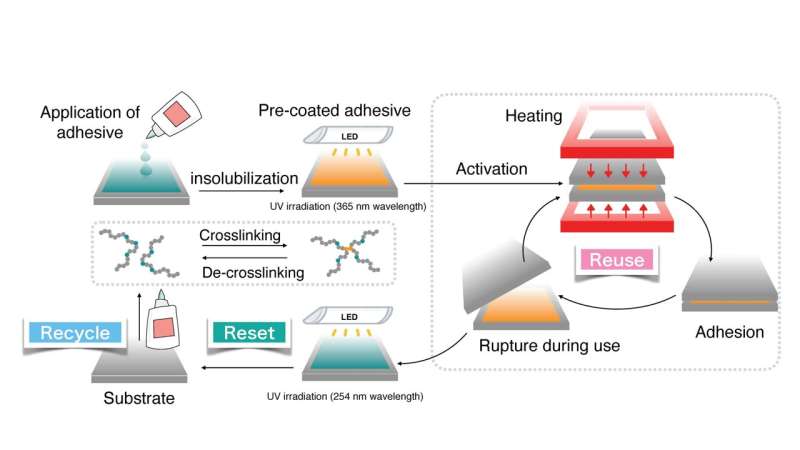This article has been reviewed according to Science X's editorial process and policies. Editors have highlighted the following attributes while ensuring the content's credibility:
fact-checked
peer-reviewed publication
trusted source
proofread
Renewable adhesive may offer an effective means of adhesion underwater

The National Institute for Materials Science (NIMS) has developed a renewable adhesive that allows for repeated bonding and debonding, and can reset the substrate and adhesive to their original state when needed.
With increasing awareness of the need to balance environmental concerns with economic growth, there is a demand for technologies that enable the separation and recovery of multi-component molded products. In this context, attention is being focused on a new bonding method that provides sufficient adhesion during use and easy release once its purpose has been fulfilled.
The challenge is to reconcile the conflicting elements of strong adhesion and easy removal. Furthermore, even when debonding is achieved, issues such as adhesive residue on the substrate or substrate damage have hindered material flow.
In this study, the research team focused on caffeic acid, which can reversibly induce cross-linking and debonding reactions by irradiation with ultraviolet (UV) light of different wavelengths. This research was published in Advanced Functional Materials.
A polymer containing caffeic acid was applied to a substrate and, upon exposure to 365 nm UV light, it formed a cross-linked film that became insoluble. This film shows no adhesion when stored at room temperature, but can be repeatedly bonded and unbonded when heated.
Furthermore, when the film is exposed to 254 nm UV light at the end of its service life, the cross-linked portions break and return to the same state as before application, allowing both the adhesive and the substrate to be recovered and reused.
In addition, the catechol groups present in the chemical structure of caffeic acid are commonly found in adhesive components secreted by attaching organisms such as mussels. This adhesive demonstrated strong adhesion and recyclability even with substrates and environmental conditions that are challenging for conventional adhesives, such as fluoropolymers and underwater adhesion.
In future research, the team will investigate the effectiveness of this adhesive in repairing various technologies, including electronic devices, transport equipment, medical equipment and physical infrastructure with the aim of contributing to a circular economy.
This project was carried out by a research team led by Masanobu Naito (Macromolecules Field Director, Research Center for Macromolecules and Biomaterials (RCMB), NIMS) and Siqian Wang (Postdoctoral Researcher, RCMB, NIMS).
More information: Siqian Wang et al, Bio‐Inspired Adhesive with Reset‐On Demand, Reuse‐Many (RORM) Modes, Advanced Functional Materials (2023). DOI: 10.1002/adfm.202215064
Journal information: Advanced Functional Materials
Provided by National Institute for Materials Science





















